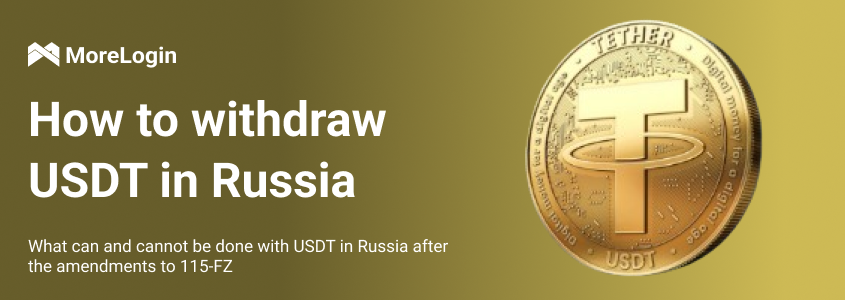
- Product

- Pricing
- Affiliate Program
- Use Cases
- Resource


Every month, the risks of working with crypto in Russia are becoming more tangible.
This especially applies to withdrawing USDT to a bank card—whether you're a freelancer, an affiliate marketer, or just a “private individual.” The screws are tightening, and regulatory pressure is growing. Under the pretense of fighting money laundering, fraud, and illegal cash-outs, anyone involved in P2P or crypto exchanges is coming under scrutiny.
How can you withdraw crypto directly to fiat?
What amounts won’t raise red flags?
Do you need to register as self-employed?
What happens if you're using drop cards?
In this article, we’ll break it all down.
It used to be simple: go to BestChange, pick an exchanger, transfer funds to your card—and you’re done. Now, it's a lottery. Many exchanges split payments into several smaller transactions, minimum limits are increasing, and banks are getting more cautious. Why?
Because most exchangers still operate through drop cards—bank accounts registered to individuals who are paid to "lend" their accounts. When regulators catch these drops, they often file fraud complaints to avoid responsibility. As a result, all transactions linked to those cards can be frozen—including your main bank account.
In the worst-case scenario, you may have no idea you’ve been part of a criminal scheme:
You send USDT to an exchanger, they send you rubles… but those rubles might be stolen money from a scam victim. Legally, you’ve just helped launder money.
Under Federal Laws No. 115-FZ ("On Countering Money Laundering") and No. 161-FZ ("On the National Payment System"), cryptocurrency as an asset is not banned.
However, there are strict limitations regarding how crypto can be used in everyday life and business:
You are allowed to:
Hold and buy cryptocurrency
Invest in crypto
Sell it on exchanges or through exchangers
You are prohibited from:
Paying for goods/services in crypto in Russia
Receiving salary or freelance payments in crypto without declaring them
Using anonymous exchanges that don’t verify user identities
Amendments effective from June 2025 tightened compliance requirements for banks, exchanges, and exchangers:
Mandatory KYC (Know Your Customer) identity verification
Ongoing monitoring of all user transactions
Mandatory reporting of suspicious activity to Rosfinmonitoring (Russia’s financial watchdog)
This means anyone wanting to legally interact with crypto must now verify their identity and stay transparent. Transactions will be monitored, and anything suspicious will be flagged automatically.
In short, the government aims to bring the crypto sector out of the shadows:
Stop illegal cash-outs
Track money flows on-chain (with tools like “Transparent Blockchain”)
Enforce financial transparency and tax compliance
Under 115-FZ, even regular account activity may attract attention if it resembles money laundering or cash-out schemes.
The following may trigger a financial investigation:
A large number of incoming transfers from individuals
For example: If your card receives payments from dozens of different senders in a short period
More than 10 incoming transfers a day, or 50+ a month, may look like you’re operating an illegal payment gateway or laundering income
Such patterns are red flags for bypassing tax or financial controls.
Signals that trigger financial monitoring:
Many transfers from different individuals (for example, more than 10 per day or over 50 per month)
Large incoming amounts — 100,000 RUB per day or 1 million RUB per month
Immediate withdrawal after funds are received
No payments for utilities, shopping, or internet — the account looks like a “pass-through”
A high number of transactions during the day
Logins from different accounts on the same device (a common sign of drop account usage)
Any of these factors can lead to unpleasant consequences. The bank may suspend a transaction until the circumstances are clarified, request supporting documents, or pass the information to Rosfinmonitoring. In turn, Rosfinmonitoring may initiate an investigation, involve the tax service or law enforcement to analyze the origin of funds more deeply.
If your activity seems suspicious:
The bank may freeze the transfer for investigation.
Rosfinmonitoring may request explanations: who sent the money, where the crypto came from, and whether you're paying taxes.
The tax authorities may decide you're evading taxes and impose back taxes and fines.
If you're linked to money laundering or fraud, it could even become a criminal case.
There are also discussions about fines of up to 200,000 RUB and confiscation of crypto for using USDT as a “money surrogate.”
The safest way is to register as a self-employed individual:
You only pay 4% tax on income from individuals (up to 2.4 million RUB per year)
You can legally receive crypto payments, convert them to rubles, and declare them
Use the "My Tax" app to keep records
This is the simplest way to prove the source of your funds
Additional safety measures:
Break up large amounts into smaller transfers
Use cards with verified identification (such as Binance or AdvCash)
Save screenshots of chats, agreements with clients, and exchange receipts
Avoid P2P via drop accounts — use KYC-compliant platforms
To protect your accounts and work safely across multiple exchanges and wallets, you can use anti-detect browsers such as MoreLogin. This helps separate profiles, minimize your digital footprint, and reduce the risk of blocks — especially useful if you manage multiple accounts or platforms.
In 2025, cryptocurrency remains legal in Russia but is strictly regulated. The government does not prohibit the ownership or trading of digital assets but requires full transparency and compliance with all financial control laws. The key to safely working with crypto is official identification, paying taxes, and avoiding gray schemes.
If you honestly declare your income, stay within the set limits, and avoid suspicious operations, your activity will be within the law. With a competent approach, crypto in Russia can not only be an investment tool but also a stable source of income — without unnecessary risks or anxiety.